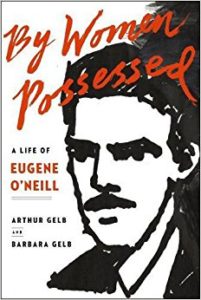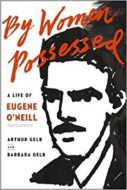Book Review: By Women Possessed: A Life of Eugene O’Neill
 By Women Possessed: A Life of Eugene O’Neill
By Women Possessed: A Life of Eugene O’Neill
Barbara and Arthur Gelb
New York: Marian Wood Books/Putnam, 2016
ISBN 978-0399159114
Eugene O’Neill’s towering predominance among American dramatists is, quite simply, undeniable. Winner of a Nobel Prize, a record four Pulitzer Prizes, his fifty-plus plays written beginning in the late 1910s established a standard for Broadway drama few peers could hope to equal. Only Tennessee Williams, Arthur Miller, and perhaps Edward Albee and August Wilson, challenged the ambition, experimentation, and overall accomplishment of O’Neill. As biographers Barbara and Arthur Gelb make all too clear in By Women Possessed: A Life of Eugene O’Neill, the price for this achievement was costly – the playwright’s turbulent life equaled or surpassed even the darkest of his plays for wrenching tragedy. As the title suggests, the Gelbs make a potent case for the importance of three women in the development of themes of his work, and the result is persuasive.
Prior to this new book, the Gelbs 924-page biography, O’Neill (Harper & Row, 1962), attempts to reveal O’Neill’s hitherto little-known personal story. From his disturbed childhood (shattered by learning of his mother’s drug addiction) to his rise to dramatic prominence, and his ultimate withdrawal into seclusion around 1934, O’Neill wrote what are now regarded as his masterworks, Long Day’s Journey Into Night, The Iceman Cometh, and A Moon for the Misbegotten in this presumably fallow period of illness and depression. In the aftermath of his 1953 death, and following an acclaimed posthumous 1956 production of his semi-autobiographical masterpiece, Long Day’s Journey Into Night, a fuller picture of the man and his work has emerged. Writing O’Neill in the aftermath of the triumph of Long Day’s Journey, the Gelbs subsequently revised that well-received book as new information came to light, including previously unknown material located in Ireland about the life of actor James O’Neill, the playwright’s father. Revising again under the title O’Neill: Life with Monte Cristo (Applause Books, 2000), the Gelbs paid close attention, as the new title suggests, to O’Neill’s complex relationship with his famous father.
More recently, as the diaries of Carlotta Monterey, O’Neill’s third wife, literary executor, and, as Carlotta herself stated, “Wife, mistress, mother, nurse, friend, secretary, his ‘buffer’ to the world,” (p. 500) emerged, the Gelbs produced this latest volume. Along with Monterey, the Gelbs set their sights on O’Neill’s mother, Ella, and his second wife, writer Agnes Boulton. Despite previously worthy biographical efforts, especially Robert M. Dowling’s Eugene O’Neill: A Life in Four Acts (Yale University Press, 2014), and numerous critical studies, collections of letters, interviews, and memoirs by family and friends (including Boulton), O’Neill’s legacy has been viewed from multiple angles and with various agendas, though the Gelbs remain the forerunning keepers of the flame.
The depth of research evident, along with a generous sampling of photographs (some previously unpublished), and the application of new sources, make this work an essential volume. Casual readers may find its length and density daunting, but to those seeking illumination about the inspirations on and aspirations of O’Neill’s plays, By Women Possessed offers a portrait of the man as his work. O’Neill sacrificed much, including his wives and children, to achieve his lofty dramatic ambitions, and the Gelbs’ portrait merges the heady triumphs, depths of despair and loss, and even humor that offers a key to any attempt to understand this remarkable genius of American drama.
James Fisher
The University of North Carolina at Greensboro

